A Tab Stop in word processing terms is the jump your cursor makes from one position to another when you press the tab key on your keyboard. Your tab key looks like this:
Press the tab key on your keyboard and watch what happens. You'll see the cursor jump from left to right in your document. Press the backspace key on your keyboard to get back to where you were. Or just click with your left mouse button.
You typically set tab stop positions for things like indenting the first line of a paragraph, or if you wanted text to start three or four centimetres along the line. We're going to set three tab stops for our line of text with the months of the year.
With your Crime Statistics document open, do the following:
- Move your cursor to the start of the January, February, March line of text in your document
- Locate the Paragraph panel in the Home ribbon at the top of Word
- Click the small arrow in the bottom right of the Paragraph panel:

When you click the arrow you should see a dialogue box appear. This one:
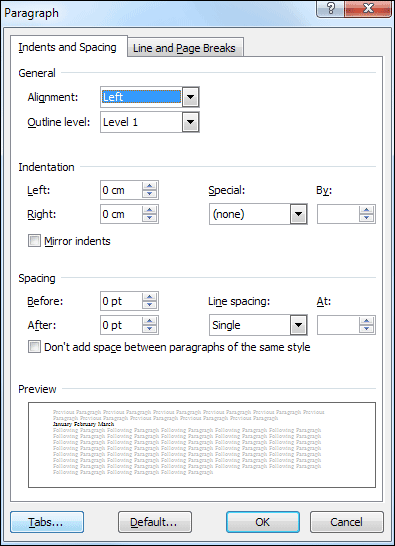
Click the Tabs button in the bottom left. Another dialogue box will appear, and will look like this:
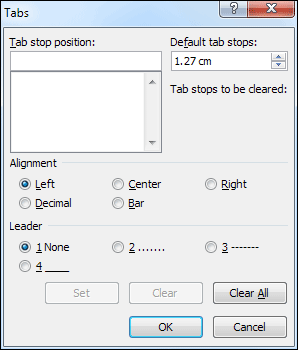
The area to concentrate on is Tab stop position, right at the top. When you want to set a tab stop, you type in a number in the text box below the words "Tab stop position". Then you press the "Set" button.
We are going to set tab stop positions at 3, 5 and 7 centimetres from the left hand side. (If your Word measurements are set to inches the figures to use are 1.18, 1.97, and 2.75.)- Enter a 3 in the Tab stop position text box
- Click the "Set" button
- Enter a 5 in the Tab stop position text box
- Click the "Set" button
- Enter a 7 in the Tab stop position text box
- Click the "Set" button
When you are finished, your Tab dialogue box should look like this:
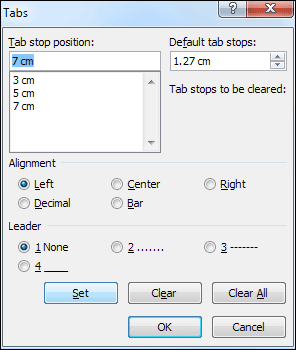
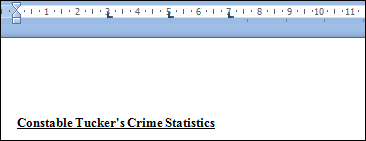


The tab stops have vanished because we only set them for one line - the months of the year line. To set tab stops for the numbers, highlight the same area of text as in the image below:
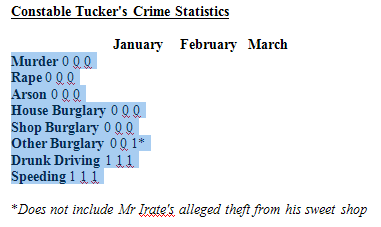
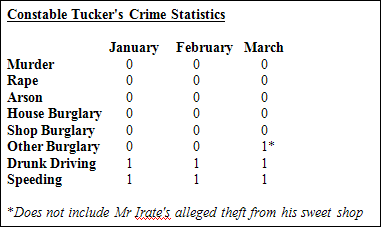 I'm sure you'll agree that Constable Tucker's statistics are looking a lot tidier. We can do something else, though, and that is add some bullets to the list of crimes. After all, what crime list would be complete without bullets!
I'm sure you'll agree that Constable Tucker's statistics are looking a lot tidier. We can do something else, though, and that is add some bullets to the list of crimes. After all, what crime list would be complete without bullets!

Click the OK button when you have finished. With your cursor still flashing before the J of January, your top ruler bar will look like this:

Notice the three L-shaped lines on your ruler bar. These are your three tab stop positions.
If you can't see the ruler bar, click the View ribbon at the top of Microsoft Word. Locate the Show/Hide panel and select the ruler item:
To move your text along, position your cursor before the J of January. Press the tab key on your keyboard. The entire line will shift to right, and January will now be lined up with your first tab stop at position 3. Position your cursor before the letter "F" of February, and then press your tab key again. February will be lined up with your second tab stop at position 5.
Position your cursor before the letter "M" of March, and then press your tab key again. March will be lined up with your third tab stop at position 7. Your document will now look like this:
You can see that the three months are lined up with the three tab stops in the ruler bar at the top.
Now move your cursor down one line and watch what happens to the ruler bar at the top. The tab stops have vanished!The tab stops have vanished because we only set them for one line - the months of the year line. To set tab stops for the numbers, highlight the same area of text as in the image below:

When your text is highlighted, bring up the Tabs dialogue box again. Set three tabs at the following tab stop positions: 3.5, 5.5, 7.5 centimetres. (In inches, 1.37, 2.16, 2.95.)
When you're finished, every line in the highlighted area will have tab stops at those three positions. You now need to shift the numbers across so that one number is underneath one month. So position your cursor before the first number and press your tab key. Position your cursor before the second number and press your tab key. Position your cursor before the third number and press your tab key. Do that for every line of numbers. When you're done, it should look like this one:
No comments:
Post a Comment